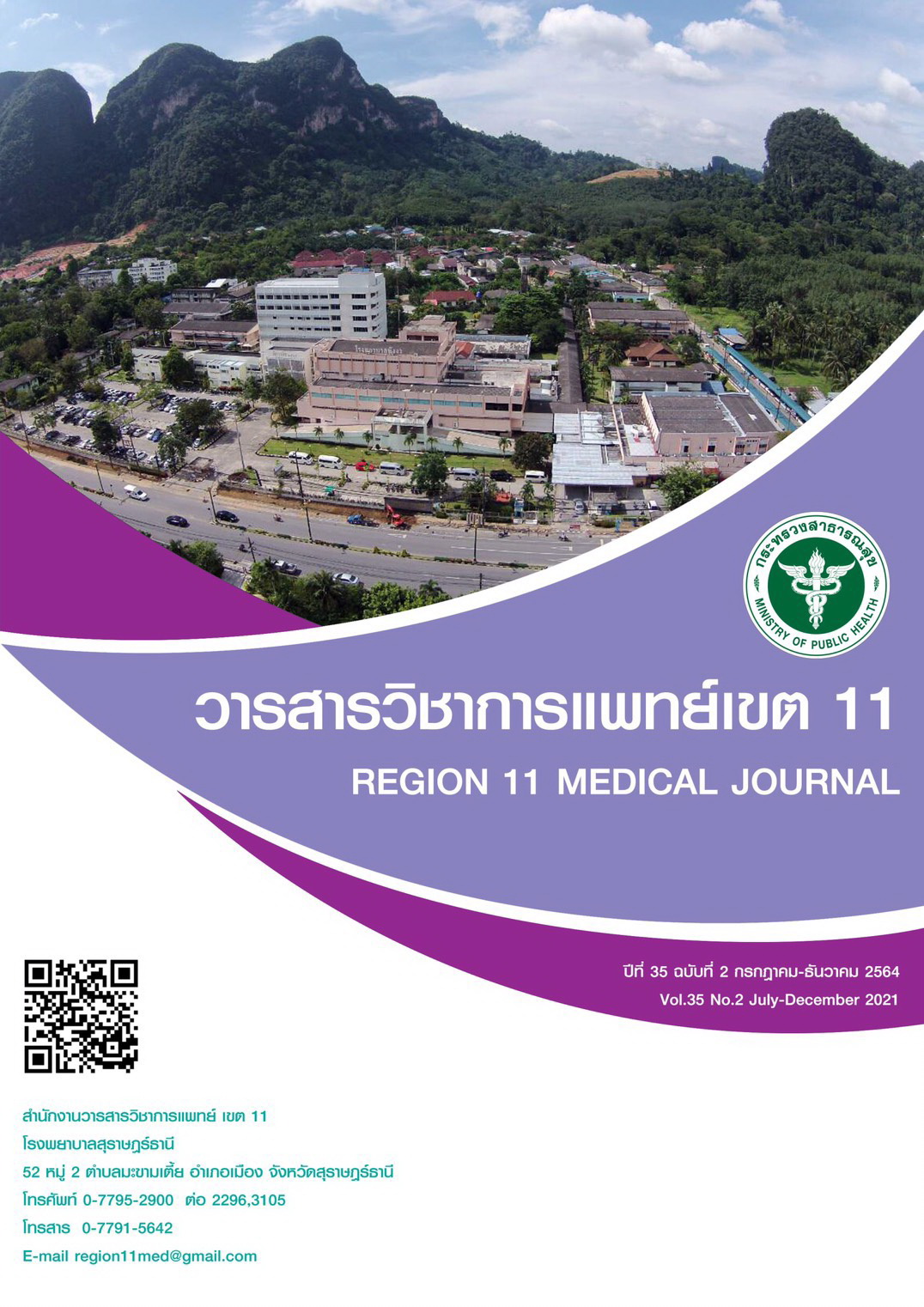Outcome of Subacute Post-stroke Rehabilitation in Outpatient-based VS Home-based
Keywords:
Post-stroke rehabilitation, Home-based program, Intermediate care, Barthel indexAbstract
Background: Improvement process of rehabilitation system for subacute post stroke patients in Vachira Phuket Hospital.
Objectives: To explore outcome of home-based and outpatient-based setting rehabilitation in subacute post stroke patients who had moderate dependency and to compare the outcome of two group.
Method: Retrospective review medical records of 76 stroke patients who had moderate dependency when discharged from Vachira Phuket Hospital since September 2018 to October 2019. Multidisciplinary team assesses the patients before discharge from hospital. Barthel index Thai version and return to work rate are used. Patients get rehabilitation and follow until BI full =20 or reach 6 months.
Results: Both therapy groups improved significantly in activities of daily living (p<0.001). Outpatient group had significantly higher improvement of Barthel index from baseline (p-value = 0.047) Return to work rate is not difference between 2 groups (p-value = 0.484)
Conclusion: although out-patient based rehabilitation can improve ADL more than home-based rehabilitation, return to work rates are not different in both groups.
References
กระทรวงสาธารณสุข. สำนักปลัดกระทรวงสาธารณสุข. กองยุทธศาสตร์และแผนงาน. กลุ่มข้อมูลข่าวสารสุขภาพ. หนังสือสถิติสาธารณสุข พ.ศ. 2561. นนทบุรี; 2562.
มูลนิธิเพื่อการพัฒนานโยบายสุขภาพระหว่างประเทศ สำนักงานพัฒนานโยบายสุขภาพระหว่างประเทศ. การสูญเสียปีสุขภาวะ Disability-Adjusted life year: DALY รายงานภาระโรคและการบาดเจ็บของประชากรไทย พ.ศ. 2556. นนทบุรี: เดอะกราฟิโกซิสเต็มส์ จำกัด; 2558.
รัชวรรณ สุขเสถียร. การเข้าถึงบริการเวชกรรมฟื้นฟูโรคหลอดเลือดสมองระยะ เฉียบพลันแบบผู้ป่วยใน ณ โรงพยาบาลมหาราชนครราชสีมา : ปัจจัยที่เกี่ยวข้องและผลลัพธ์. ASEAN J Rehabil Med. 2014; 24(2):37-43.
ฐานกุล คำนูณทรัพย์. ปัจจัยการเข้าถึงการบำบัดรักษาฟื้นฟูสภาพของผู้ป่วยโรคหลอดเลือดสมอง โรงพยาบาลกระบี. วารสารวิชาการแพทย์เขต 11. 2019;33(3):507–16.
ธัญลักษณ์ ขวัญสนิท. ผลการพัฒนาระบบฟื้นฟูระยะกึ่งเฉียบพลัน (Sub-acute rehabilitation) ในผู้ป่วยหลอดเลือดสมอง โรงพยาบาลสุราษฎร์ธานี. วารสารวิชาการแพทย์เขต 11 2017;31(4):723–32.
สำนักงานวิจัยและพัฒนากำลังคนด้านสุขภาพ (สวค.) มูลนิธิเพื่อการพัฒนานโยบายสุขภาพระหว่างประเทศ. รายงานฉบับสมบูรณ์โครงการวิจัยเรื่อง การประเมินผลระบบการให้บริการการดูแลระยะกลาง (intermediate care). นนทบุรี: สำนักงานพัฒนานโยบายสุขภาพระหว่างกระเทศ (IHHP); 2562.
Chen S, Lv C, Wu J, Zhou C, Shui X, Wang Y. Effectiveness of a home- based exercise program among patients with lower limb spasticity post- stroke: A randomized controlled trial. Asian Nurs Res. 2021;15(1):1-7. doi: 10.1016/j.anr.2020.08.007.
กระทรวงสาธารณสุข. กรมการแพทย์. สถาบันประสาทวิทยา. แนวทางการฟื้นฟูสมรรถภาพผู้ป่วยโรคหลอดเลือดสมอง. นนทบุรี; 2550.
สุภัททา พุฒฤทธิ์. ผลของระบบบริการฟื้นฟูในผู้ป่วยโรคหลอดเลือดสมองระยะกึ่งเฉียบพลันระหว่างการดูแลแบบผู้ป่วยใน ผู้ป่วยนอก และที่บ้าน. พุทธชินราชเวชสาร 2563;37(1):83-91.
กัญญารัตน์ ค้ำจุน, ปานจิต วรรณภิระ, ปราญปริญ ปิ่นสกุล, ศศิธร สมจิตต์. การพัฒนางานฟื้นฟูผู้ป่วยโรคหลอดเลือดสมองระยะกลางแบบต่อเนื่องสู่ชุมชน. พุทธชินราชเวชสาร 2561;35(3):304-12.
สุทธิกิตติ์ พิพัฒน์ศรีสวัสดิ์. ผลลัพธ์การฟื้นฟูสมรรถภาพในผู้ป่วยโรคหลอดเลือดสมองระยะกลาง. เชียงรายเวชสาร 2563;12(3)47-56.
López-Liria R, Vega-Ramírez FA, Rocamora-Pérez P, Aguilar-Parra JM, Padilla-Góngora D. Comparison of Two Post-Stroke Rehabilitation Programs: A Follow-Up Study among Primary versus Specialized Health Care. PLoS ONE 2016;11(11): e0166242. doi:10.1371/journal. pone.0166242 .
Rasmussen RS, Østergaard A, Kjær P, Skerris A, Skou C, Christoffersen J, et al. Stroke rehabilitation at home before and after discharge reduced disability and improved quality of life: a randomized controlled trial. Clin Rehabil; 2016 Mar;30(3):225-36.
Nordin NAM, Aziz NA, Sulong S, Aljunid SM. Effectiveness of home-based carer- assisted in comparison to hospital-based therapist-delivered therapy for people with stroke: A randomized controlled trial. NeuroRehabilitation; 2019; 45:1:87-97.
Anderson C, Rubenach S, Mhurchu CN, Clark M, Spencer C, Winsor A. Home or hospital for stroke rehabilitation? results of a randomized controlled trial : I: health outcomes at 6 months. Stroke. 2000 May;31(5):1024-31.
Han J, Lee HI, Shin YL, Son JH. Factors influencing return to work after stroke: The Korean Stroke Cohort for Functioning and Rehabilitation (KOSCO) Study. BMJ Open 2019;9:e028673. doi:10.1136/bmjopen-2018-028673.
Westerlind E, Persson HC, Sunnerhagen KS. Return to Work after a Stroke in Working Age Persons; A Six-Year Follow Up. PLoS ONE 2017;1(6)doi.org/10.1371/journal.pone.0169759
คณะอนุกรรมการพัฒนาระบบบริการสาธารณสุข (Service Plan) สาขาการดูแลระยะเปลี่ยนผ่านผู้ป่วยกึ่งเฉียบพลัน. คู่มือการฟื้นฟูสมรรถภาพผู้ป่วยระยะกลางสำหรับบุคลากรทางการแพทย์ตามแผนพัฒนาระบบบริการสุขภาพ. สมุทรสาคร: บอร์นทูบีพับลิชชิ่งจำกัด; 2562






